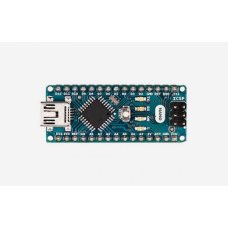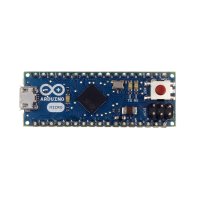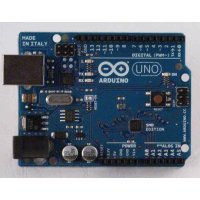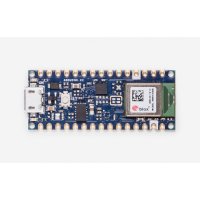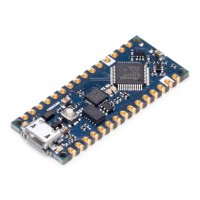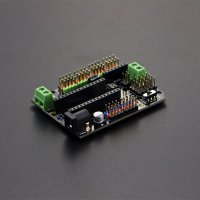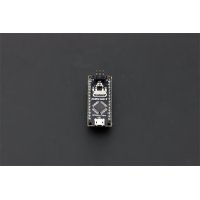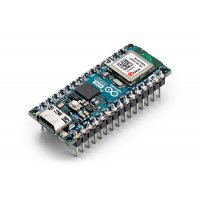The Arduino Nano is a small, complete, and breadboard-friendly board based on the ATmega328P (Arduino Nano 3.x). It has more or less the same functionality of the Arduino Duemilanove, but in a different package. It lacks only a DC power jack, and works with a Mini-B USB cable instead of a standard one.
Specifications:
| Microcontroller | ATmega328 |
| Architecture | AVR |
| Operating Voltage | 5 V |
| Flash Memory | 32 KB of which 2 KB used by bootloader |
| SRAM | 2 KB |
| Clock Speed | 16 MHz |
| Analog IN Pins | 8 |
| EEPROM | 1 KB |
| DC Current per I/O Pins | 40 mA (I/O Pins) |
| Input Voltage | 7-12 V |
| Digital I/O Pins | 22 (6 of which are PWM) |
| PWM Output | 6 |
| Power Consumption | 19 mA |
| PCB Size | 18 x 45 mm |
| Weight | 7 g |
| Product Code | A000005 |
Power
The Arduino Nano can be powered via the Mini-B USB connection, 6-20V unregulated external power supply (pin 30), or 5V regulated external power supply (pin 27). The power source is automatically selected to the highest voltage source.
Memory
The ATmega328 has 32 KB, (also with 2 KB used for the bootloader. The ATmega328 has 2 KB of SRAM and 1 KB of EEPROM.
Input and Output
Each of the 14 digital pins on the Nano can be used as an input or output, using pinMode(), digitalWrite(), and digitalRead() functions. They operate at 5 volts. Each pin can provide or receive a maximum of 40 mA and has an internal pull-up resistor (disconnected by default) of 20-50 kOhms. In addition, some pins have specialized functions:
- Serial: 0 (RX) and 1 (TX). Used to receive (RX) and transmit (TX) TTL serial data. These pins are connected to the corresponding pins of the FTDI USB-to-TTL Serial chip.
- External Interrupts: 2 and 3. These pins can be configured to trigger an interrupt on a low value, a rising or falling edge, or a change in value. See the attachInterrupt() function for details.
- PWM: 3, 5, 6, 9, 10, and 11. Provide 8-bit PWM output with the analogWrite() function.
- SPI: 10 (SS), 11 (MOSI), 12 (MISO), 13 (SCK). These pins support SPI communication, which, although provided by the underlying hardware, is not currently included in the Arduino language.
- LED: 13. There is a built-in LED connected to digital pin 13. When the pin is HIGH value, the LED is on, when the pin is LOW, it's off.
- I2C: A4 (SDA) and A5 (SCL). Support I2C (TWI) communication using the Wire library (documentation on the Wiring website).
- AREF. Reference voltage for the analog inputs. Used with analogReference().
- Reset. Bring this line LOW to reset the microcontroller. Typically used to add a reset button to shields which block the one on the board.
Communication
The Arduino Nano has a number of facilities for communicating with a computer, another Arduino, or other microcontrollers. The ATmega328 provide UART TTL (5V) serial communication, which is available on digital pins 0 (RX) and 1 (TX). An FTDI FT232RL on the board channels this serial communication over USB and the FTDI drivers (included with the Arduino software) provide a virtual com port to software on the computer. The Arduino software includes a serial monitor which allows simple textual data to be sent to and from the Arduino board. The RX and TX LEDs on the board will flash when data is being transmitted via the FTDI chip and USB connection to the computer (but not for serial communication on pins 0 and 1). A SoftwareSerial library allows for serial communication on any of the Nano's digital pins. The ATmega328 also support I2C (TWI) and SPI communication. The Arduino software includes a Wire library to simplify use of the I2C bus. To use the SPI communication, please see ATmega328 datasheet.
- 1 x Arduino Nano
Arduino Nano
- Brand: Arduino
- Product Code: Ard-Arduino-Nano
- Reward Points: 27
- Availability: Out Of Stock
- रo 2,738.00
-
रo 2,195.00
- Price in reward points: 2738
-
- 50 or more रo 1,589.00
- 100 or more रo 1,528.00
Related Products
Arduino Micro
The Micro is a microcontroller board based on the ATmega32U4, developed in conjunction with Adafruit..
रo 2,433.00
Arduino Uno Rev3 (SMD)
The Arduino Uno Rev3 SMD is a microcontroller board based on the ATmega328. It has 14 digital input/..
रo 2,211.00
Arduino Nano 33 BLE IoT Board
The Arduino Nano 33 BLE is a completely new board on a well-known form factor. It comes with an embe..
रo 2,672.00
Arduino Nano Every
The Arduino Nano is the preferred board for many projects requiring a small and easy to use microcon..
रo 969.00
Gravity: Nano I/O Shield for Arduino Nano
The Arduino Nano I/O Sensor Shield acts as an expansion board for the Arduino Nano and DFRduino Nan..
रo 657.00 रo 758.00
DFRduino Nano V3.1
The DFRduino Nano USB Microcontroller V3.1 (ATMega 328) is a breadboard ready version of the " Ardui..
रo 997.00 रo 1,149.00
Arduino Nano ESP32 with headers
Note: The Arduino Nano ESP32 with headers is available for pre-order and is expected to be shipped i..
रo 2,200.00 रo 2,037.00
Tags: Arduino, ATmega328P

